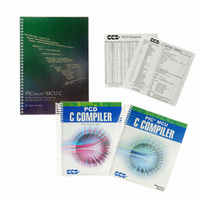PCWHD IDE COMPILER Custom Computer Services Inc (CCS), PCWHD IDE COMPILER Datasheet - Page 345

PCWHD IDE COMPILER
Manufacturer Part Number
PCWHD IDE COMPILER
Description
PCWHD PIC10,16,18,24, DSPIC
Manufacturer
Custom Computer Services Inc (CCS)
Type
Compilerr
Datasheet
1.PCD_COMMAND_LINE_COMPILER.pdf
(373 pages)
Specifications of PCWHD IDE COMPILER
For Use With/related Products
Microchip PIC10, PIC12, PIC16, PIC18, PIC24, dsPIC MCUs
Lead Free Status / RoHS Status
Not applicable / Not applicable
Other names
429-1009
- Current page: 345 of 373
- Download datasheet (4Mb)
COMMON QUESTIONS AND ANSWERS
How do I directly read/write to internal registers?
A hardware register may be mapped to a C variable to allow direct read and write capability to the
register. The following is an example using the TIMER0 register:
#BYTE timer 1 = 0x 100
timer0= 128; //set timer0 to 128
while (timer 1 ! = 200); // wait for timer0 to reach 200
Bits in registers may also be mapped as follows:
#BIT T 1 IF = 0x 84.3
.
.
.
while (!T 1 IF); //wait for timer0 interrupt
Registers may be indirectly addressed as shown in the following example:
printf ("enter address:");
a = gethex ();
printf
("\r\n value is %x\r\n", *a);
The compiler has a large set of built-in functions that will allow one to perform the most common
tasks with C function calls. When possible, it is best to use the built-in functions rather than directly
write to registers. Register locations change between chips and some register operations require a
specific algorithm to be performed when a register value is changed. The compiler also takes into
account known chip errata in the implementation of the built-in functions. For example, it is better to
do set_tris_ B (0); rather than *0x 02C6 =0;
331
Related parts for PCWHD IDE COMPILER
Image
Part Number
Description
Manufacturer
Datasheet
Request
R

Part Number:
Description:
PROTOTYPING BOARD FOR PIC MCU
Manufacturer:
Custom Computer Services Inc (CCS)

Part Number:
Description:
Extra CCS C Manual
Manufacturer:
Custom Computer Services Inc (CCS)

Part Number:
Description:
MACH X Programmer
Manufacturer:
Custom Computer Services Inc (CCS)

Part Number:
Description:
PCD For 24-bit (PIC24/dsPIC)
Manufacturer:
Custom Computer Services Inc (CCS)

Part Number:
Description:
LOAD-n-GO Programmer
Manufacturer:
Custom Computer Services Inc (CCS)

Part Number:
Description:
EMBEDDED INTERNET DEVELOPMENT KIT W/PCWH
Manufacturer:
Custom Computer Services Inc (CCS)

Part Number:
Description:
PIC24F Development Kit With PCWHD
Manufacturer:
Custom Computer Services Inc (CCS)

Part Number:
Description:
PIC24F Development Kit With PCDIDE
Manufacturer:
Custom Computer Services Inc (CCS)

Part Number:
Description:
PIC24H Development Kit With PCWHD
Manufacturer:
Custom Computer Services Inc (CCS)

Part Number:
Description:
PIC24H Development Kit With PCDIDE
Manufacturer:
Custom Computer Services Inc (CCS)

Part Number:
Description:
PIC18F6722 Embedded C Development Kit With PCWH Compiler
Manufacturer:
Custom Computer Services Inc (CCS)

Part Number:
Description:
PIC18F8722 Embedded C Development Kit With PCWH Compiler
Manufacturer:
Custom Computer Services Inc (CCS)

Part Number:
Description:
USB Master Prototyping Board
Manufacturer:
Custom Computer Services Inc (CCS)










